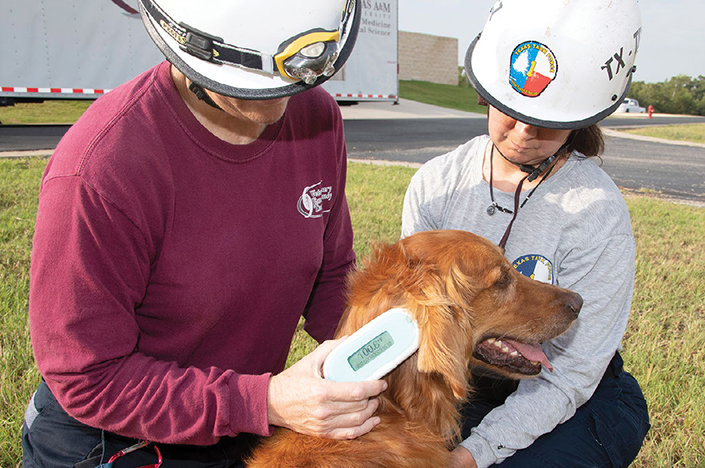Microchip may help responders monitor search-and-rescue dogs

They are, perhaps, among the unsung heroes of the rescue world.
The canine members of the Texas A&M Task Force (TX-TF) urban search and rescue (SAR) teams can do many things their human counterparts can’t: their athletic frames and fearlessness allow them to squeeze into tight spaces, their agility allows them to maneuver unstable surfaces, and their exquisitely sensitive, trained noses allow them to sniff out the missing (through microscopic molecules in your breath!) to a precision unthinkable for humans.
The impact these dogs make cannot be denied. But the work is incredibly dangerous—the nature of the job requires them to work in all environments and around many hazards.
“The most successful SAR dogs are very highly driven; they do not make good pets. They are the most intense creatures in the dog world,” said Deb Zoran, a professor of small animal medicine in the Texas A&M College of Veterinary Medicine & Biomedical Sciences’ Small Animal Clinical Sciences department.
“When they and their handlers get deployed into a disaster, the mission is to find, save, or recover missing people, and they often have to go to work on a moment’s notice,” she said. “The first 48 to 72 hours are crucial in a disaster—that’s the critical timeframe you have to work in— and you don’t get to pick the circumstances.”
Zoran pulls double duty as a member of the Texas A&M Veterinary Emergency Team (VET) and the team veterinarian for TX-TF 1 & 2. For the past 10 years, her primary objective when training or deploying with either team is to keep these dogs healthy, at peak performance, and mission ready.
To her, the relationship between the SAR dogs, their handlers, and the veterinarian is of the utmost importance because while they’re working during a disaster—from wildfires to flooding responses and everything in between—SAR dogs depend on both their handler’s ability to recognize the tiniest differences in behavior or movement that may indicate injury and Zoran to support them before, during, and after a mission.
“When they are deployed in our Texas climate, they are at particular risk of hyperthermia, dehydration, and many injuries—muscle strains or trauma to their legs or foot pads—as well as for interactions with snakes, scorpions, fire ants, and other hazards that can happen in the process,” Zoran said.
A challenge each handler must face in the field is knowing how to spot when their dog may be getting too dehydrated or overheated, as SAR dogs work at an intensity that can be detrimental. Most handlers are not trained in animal care, and it is not possible for Zoran, or the Veterinary Emergency Team, to be with each dog as it works in the field.
So, when Zoran met Marta LaColla, the veterinary business manager of Allflex USA, and learned about their product SureSense, a microchip that had primarily been used for monitoring dairy cattle and cattle in feedlots, Zoran wondered if the product might be useful for SAR teams.
As Zoran saw it, a temperature-sensing microchip would solve a lot of problems. While she has taught handlers how to perform basic health checks on their dogs, taking a rectal temperature—the most common and accurate method to check temperature—in a working dog can be extremely challenging, if not impossible, in the field.
Finding new ways for handlers to monitor their SAR dogs’ body temperatures has been one of Zoran’s research interests over the past four years; she previously tried a thermistor capsule the dogs could swallow to measure temperature while they worked.
Allflex and Zoran worked out an arrangement to provide free microchips and specially designed microchip readers to the SAR teams, and, in return, Zoran developed a clinical trial protocol to collect temperature data, compare that data between different chip methods, and, over time, compare differences between work/rest cycles in training and deployments, as well as different environmental conditions.
It was a win-win situation for everyone involved.
“The whole idea behind the temp-sensing microchip and why it was powerful and valuable was because temperature monitoring by handlers essentially did not happen in the field; it was too hard to do,” she said. “With a SureSense reader in their pocket, the handlers can easily scan the area where the microchip was inserted and keep track of their dog’s temperature in real time.”
For research purposes, the captured data can be viewed through an app, downloaded by the handler, or directly uploaded to the cloud, where it is sent to Zoran and the Allflex team. By tracking temperatures in everything the dogs do, Zoran and Allflex were able to start establishing baseline and working temperatures by breed, sex, coat type, and other key variables.

